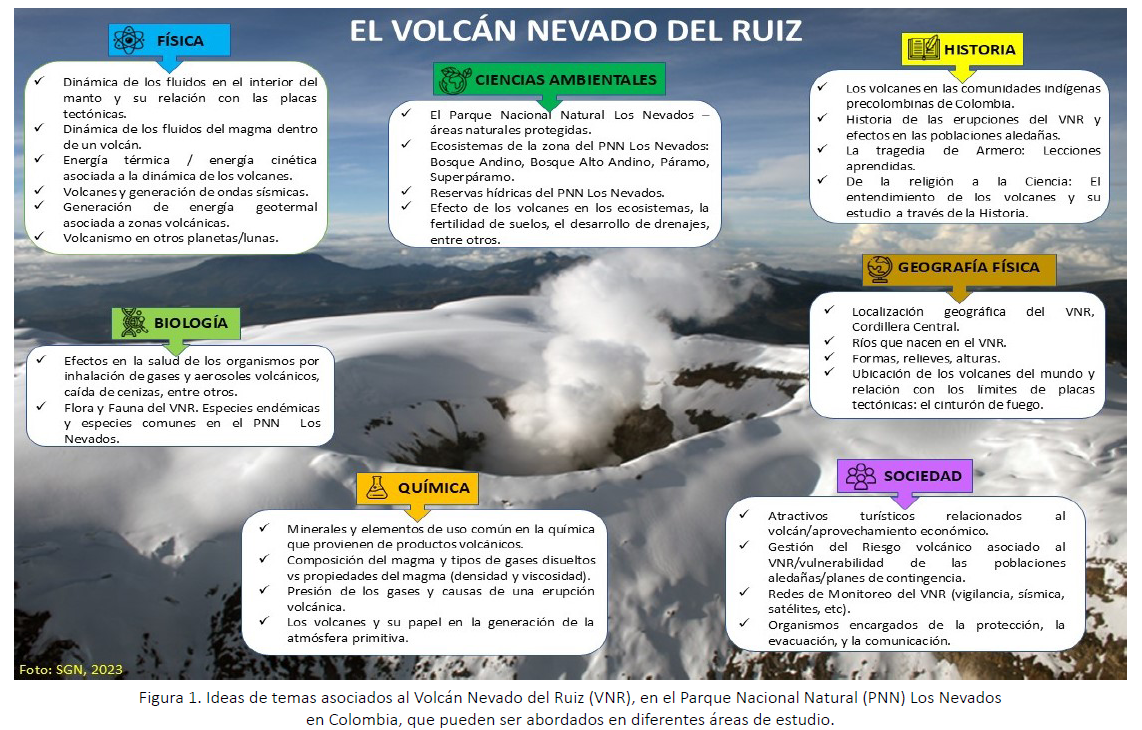Abstract
A multiple case study was conducted on four middle-high school teachers in Colombian public schools to analyze how educators from different subject matter areas teach Earth Science (ES) topics under the current curriculum design. Participants answered a 38-open-question qualitative survey and carried out a transversality exercise. According to the results, the most common topics taught are those related to the Earth and the universe, meteorology, and the environment, revealing their importance in secondary education. Overall, Natural Sciences and STEM teachers have more conceptual clarity and introduce a broader range of topics. Although we did not implement any instrument in the student groups, all teachers expressed the importance of strengthening the ES teaching in secondary education and the need to overcome the existent barriers that inder their practical application in the classroom, which include time constraints and the lack of resources and knowledge about specialized educational materials to support the instruction. We included a curricular proposal of ES topics that enhances the performance expectations consigned in the Natural and Social Sciences national standards. We encourage geoscientists and researchers in Earth Sciences Education (ESE) to explore interventional and formation strategies designed for school teachers to support the interdisciplinary integration of the ES in the curricula, improving the quality of the ESE in Colombia.
References
Arias, D., Bonan B. y Gonçalves P.W. (2018). Propuestas de formación docente para la enseñanza de las Ciencias de la Tierra en Argentina. Terræ Didatica, 14(4), 355-362.
Assarat, O., Orion, N., Menajem, O., Yarden, A., Ronen, D. y Lemcoff, J. (2007). El Planeta Azul: El ciclo del agua en los sistemas terrestres – versión en español. Instituto Weizmann de Ciencia. https://stwww1.weizmann.ac.il/geogroup/?p=458
Ayala, R.C. (2024). El CDC en Ciencias de la Tierra: Estudio de caso en cuatro docentes de educación básica secundaria y media en instituciones educativas públicas de Colombia. Trabajo de Grado, Universidad Autónoma de Manizales.
Claret, A., Villa, L.Y. y Méndez-Duque, J. (2019). La propuesta curricular de Ciencias de la Tierra en Colombia. En: Hernández, M. (Ed.), Geociencias en la educación primaria y secundaria. (Vol. I: Realidades y Oportunidades en Latinoamérica y el Caribe, pp. 42-51). Organización de las Naciones Unidas para la Educación, la Ciencia y la Cultura.
Correa, L. R. y Greco, R. (2017). La integración de temas geocientíficos para la educación en ciencias, tecnología, sociedad y medioambiente: una propuesta para el aprendizaje significativo. Enseñanza de las Ciencias de la Tierra, 25(2), 168-175.
D'Elia, L., Carrera, J., Carrera, J., López, L., D'Abramo,S., González, M., Moyano, D., Fortunato, D., Liotta, K., Pompei, J., Massenzio, A.,
Morote, M., Bilmes, A., Redigonda, J., Mendicino, J., Albarrán, K., Funes, D. y Cuevas, C. (2021). Conociendo los volcanes: Guía didáctica para la enseñanza y aprendizaje del volcanismo, su relación con el ecosistema y el ser humano. Universidad Nacional de La Plata. Andamios, Serie Materiales 7. En Memoria Académica.
Earth Sciences Teachers Association (20 de Junio de 2024). Earth Learning Idea: Innovative, Earth-related teaching ideas (Spanish). https://www.earthlearningidea.com/Indices/contents_Spanish.html
Kind, V. (2009). A conflict in your head: An exploration of trainee science teachers’ subject matter knowledge development and its impact on teacher self-confidence. International Journal of Science Education, 31(11), 1529-1562.
King, C. (2008). Geoscience education: an overview. Studies in Science Education, 44 (2), 187-222.
King, C. y Kennett, P. (2002). Earth science contexts for teaching physics. Part 1: Why teach physics in an Earth science context?. Physics Education, 37 (6), 467-469.
Lacreau, H. (2015). Geociencias para la formación ciudadana. XIV Congreso Geológico Chileno -Actas, 469-472.
Ministerio de Educación Nacional (2006). Estándares básicos de competencias. Colombia. https://www.mineducacion.gov.co/1621/articles-340021_recurso_1.pdf
Orion, N. (2019). The future challenge of Earth science education research. Disciplinary and Interdisciplinary Science Education Research 1(3), 1-8.
Plotnick, R.E., Varelas, M. y Fan, Q. (2009). An Integrated Earth Science, Astronomy, and Physics Course for Elementary Education Majors. Journal of Geoscience Education, 57 (2), 152-158.
Universidad Nacional Autónoma de México (2021). Experimentos simples para entender una Tierra complicada: Los libros de la serie. Centro de Geociencias, Universidad Autónoma de México.https://tellus.geociencias.unam.mx/index.php/serie/
Wilgenbus, D., Faure, C. y Schick, O. (2018). Cuando la Tierra ruge: proyecto de educación en riesgos en la educación básica. Guía del Profesor (Español). Le Pommier. https://fondation-lamap.org/sites/default/files/pdf_res_int/cuando-la-tierra-ruge-es.pdf
Yin, R. (2014). Case study research: Design and methods. (5a ed.). Sage.

This work is licensed under a Creative Commons Attribution-NonCommercial 4.0 International License.
Copyright (c) 2024 Universidad Nacional Autónoma de México

